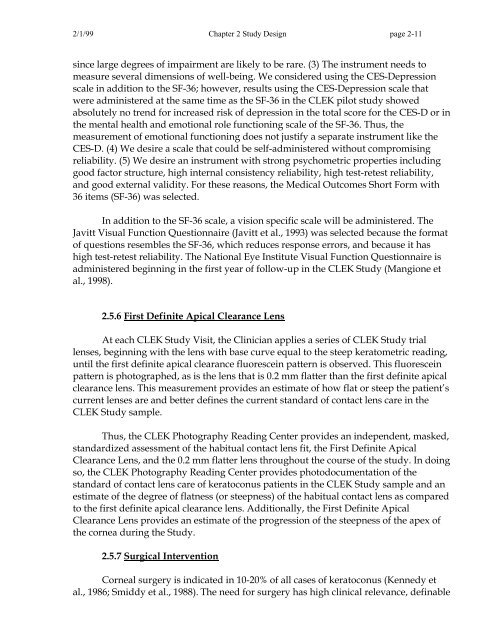OM t of c.iii - Vision Research Coordinating Center - Washington ...
OM t of c.iii - Vision Research Coordinating Center - Washington ...
OM t of c.iii - Vision Research Coordinating Center - Washington ...
Create successful ePaper yourself
Turn your PDF publications into a flip-book with our unique Google optimized e-Paper software.
2/1/99 Chapter 2 Study Design page 2-11<br />
since large degrees <strong>of</strong> impairment are likely to be rare. (3) The instrument needs to<br />
measure several dimensions <strong>of</strong> well-being. We considered using the CES-Depression<br />
scale in addition to the SF-36; however, results using the CES-Depression scale that<br />
were administered at the same time as the SF-36 in the CLEK pilot study showed<br />
absolutely no trend for increased risk <strong>of</strong> depression in the total score for the CES-D or in<br />
the mental health and emotional role functioning scale <strong>of</strong> the SF-36. Thus, the<br />
measurement <strong>of</strong> emotional functioning does not justify a separate instrument like the<br />
CES-D. (4) We desire a scale that could be self-administered without compromising<br />
reliability. (5) We desire an instrument with strong psychometric properties including<br />
good factor structure, high internal consistency reliability, high test-retest reliability,<br />
and good external validity. For these reasons, the Medical Outcomes Short Form with<br />
36 items (SF-36) was selected.<br />
In addition to the SF-36 scale, a vision specific scale will be administered. The<br />
Javitt Visual Function Questionnaire (Javitt et al., 1993) was selected because the format<br />
<strong>of</strong> questions resembles the SF-36, which reduces response errors, and because it has<br />
high test-retest reliability. The National Eye Institute Visual Function Questionnaire is<br />
administered beginning in the first year <strong>of</strong> follow-up in the CLEK Study (Mangione et<br />
al., 1998).<br />
2.5.6 First Definite Apical Clearance Lens<br />
At each CLEK Study Visit, the Clinician applies a series <strong>of</strong> CLEK Study trial<br />
lenses, beginning with the lens with base curve equal to the steep keratometric reading,<br />
until the first definite apical clearance fluorescein pattern is observed. This fluorescein<br />
pattern is photographed, as is the lens that is 0.2 mm flatter than the first definite apical<br />
clearance lens. This measurement provides an estimate <strong>of</strong> how flat or steep the patient’s<br />
current lenses are and better defines the current standard <strong>of</strong> contact lens care in the<br />
CLEK Study sample.<br />
Thus, the CLEK Photography Reading <strong>Center</strong> provides an independent, masked,<br />
standardized assessment <strong>of</strong> the habitual contact lens fit, the First Definite Apical<br />
Clearance Lens, and the 0.2 mm flatter lens throughout the course <strong>of</strong> the study. In doing<br />
so, the CLEK Photography Reading <strong>Center</strong> provides photodocumentation <strong>of</strong> the<br />
standard <strong>of</strong> contact lens care <strong>of</strong> keratoconus patients in the CLEK Study sample and an<br />
estimate <strong>of</strong> the degree <strong>of</strong> flatness (or steepness) <strong>of</strong> the habitual contact lens as compared<br />
to the first definite apical clearance lens. Additionally, the First Definite Apical<br />
Clearance Lens provides an estimate <strong>of</strong> the progression <strong>of</strong> the steepness <strong>of</strong> the apex <strong>of</strong><br />
the cornea during the Study.<br />
2.5.7 Surgical Intervention<br />
Corneal surgery is indicated in 10-20% <strong>of</strong> all cases <strong>of</strong> keratoconus (Kennedy et<br />
al., 1986; Smiddy et al., 1988). The need for surgery has high clinical relevance, definable
















